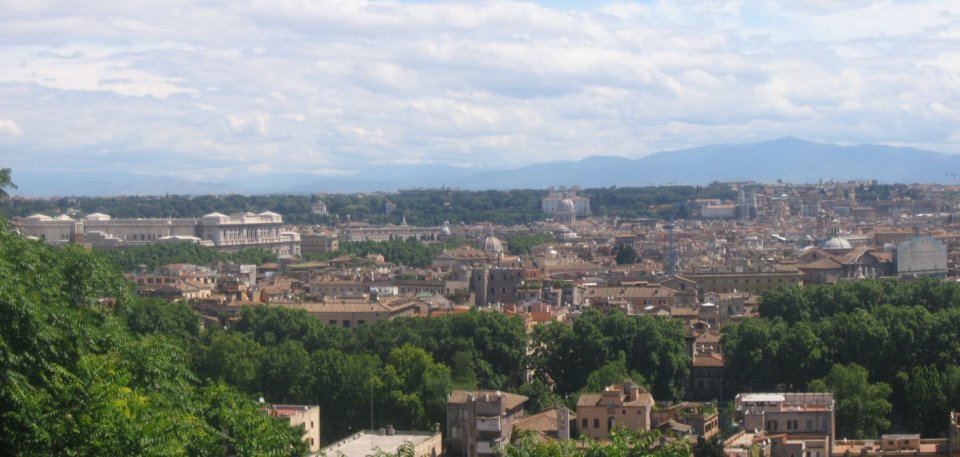
Within the EnRoute Project, the challenge of the City Lab of Rome is to apply the urban-MAES framework on a multi-scale progression.
In particular, the following policy questions have been addressed:
- Improvement of air quality at the sub-municipality level (II District – II Municipio) according to the local demand for the service and compared to the metropolitan city context. This area is characterized by high air pollutant levels such as particulate matter and tropospheric ozone (Cattani et al., 2017; Manes & Sarigiannis, 2011), which often exceed air quality thresholds for ecosystems and human health protection. The II District hosts some important historical villas and tree-lined roads (Manes et al., 2008; Silli et al., 2015). However, there is the need for a more effective measure to enhance urban and peri-urban Green Infrastructure for a sustainable strategy to be pursued by policy makers to increase resilience and to improve air quality;
- Enhancement of the cultural services associated to pollinator conservation in the II District of Rome. In alignment with the rationale of the Charter of Rome, the challenge is to stimulate positive links between Cultural and Natural Capitals in the dense urban settlement of the II District. Specifically, the scientific team and the local administration have interfaced in considering the social and cultural dimension of ecosystem management, in promoting locally-adapted activities with positive impacts on Natural Capital, and in effectively linking benefits from ecosystems (supply) with cultural and socio-economic patterns (demand)
- Promotion of synergies between biodiversity conservation/restoration and the enhancement of ES provision capacity at multiple levels (from the District to the Metropolitan City level). With respect to the 2nd target of the EU Biodiversity Strategy, the challenge is to raise awareness on attainable win-win solutions for ecosystems and their services by means of biodiversity-led and multi-functional Green Infrastructure planning and management.
The analysis of environmental, social and political aspects of the city and the identification of priority biodiversity and ES demand (e.g. restoration of degraded, fragmented or lost ecosystems; air quality improvement due to pollutant levels exceeding air quality thresholds) represented the first project phase.
Secondly, the choice of the study area was performed by means of ecosystem mapping, characterisation of ecosystem properties and condition, and spatial analysis of relevant ES processes. A comprehensive list of suitable indicators was identified (4th report MAES), and the selection of appropriate modelling and monetary valuation for air quality was performed. Pollinators support was planned with the entomologist and floristic experts of the research team and with the II District policy makers. In order to promote synergies between biodiversity and ES and between Natural and Cultural Capital, collected knowledge on the variety, pressures and condition of local biodiversity and natural ecosystems underpinned the overall process.
Key steps are represented by the following meetings with EnRoute coordinators and JRC researchers, City Labs researchers and local administration staff:
Kick-off meeting in Rome (7-8/03/2017); Meeting in Malta (13-14/06/2017); Meeting in Ispra (07/02/2018); Webinar (23/03/2018); Meeting in Sofia (24-25/04/2018); Meeting in Rome (3-7/07/2018) for ES analysis and mapping (air quality, pollination) and Ecoregional framework of European cities; phone calls with the EnRoute coordinators.
Choices were substantially taken by researchers. The Local Administration had an essential role in recommending priority green spaces for the selected actions.
The interaction between the policymakers and the scientists resulted:
Key elements for success are mapping and monetary assessment of regulating ES to be transferred to policy makers and awareness raising in the public administration on the importance of biodiversity and ES.
Pitfalls are lack of data, budget limitations and difficulties in setting an effective SPI.
|
POLICY QUESTION |
INDICATOR |
STATUS |
|
Improvement of air quality |
ES: Capacity indicator for air quality regulation (pollutants removed by vegetation in kg/ ha * year) |
Available for PM10 and O3 removal at different administrative levels (2003, 2017) |
|
PRESSURE: air pollutants concentration (µg/m3,ppm) |
Available for PM10 and O3at different administrative levels (2003, 2011, 2017) |
|
|
Cultural service of pollinator conservation |
STATE of BIODIVERSITY: occurrence and distribution of wild pollinators |
Collected from literature for the urban sector of the Municipality (within the Main Ring Road) |
|
ES demand: potential use of green spaces for nature-based education |
Available from the II District map of public green spaces |
|
|
ES Providing Units: suitable public green spaces for supporting wild bee populations |
Assessment of green space suitability originally performed for the EnRoute project (extent, current tree cover, distance from potential source populations, distance from disturbance sources) |
|
|
Biodiversity conservation and restoration |
PRESSURE: ecological impacts of urbanization trend |
Available for the Municipality of Rome Capital |
|
STATE of ECOSYSTEMS: degree of naturalness |
Available for the Metropolitan City and the Municipality |
|
|
STATE of LAND USE: Landscape conservation status |
Available for the Metropolitan City and for the Municipality according to different ecological classification of land units. Not suitable to be performed at the level of the administrative unit “Municipio II” |
|
|
URBAN BIODIVERSITY: occurrence and distribution of representative native plant species |
Available for the overall urban sector of the Municipality |
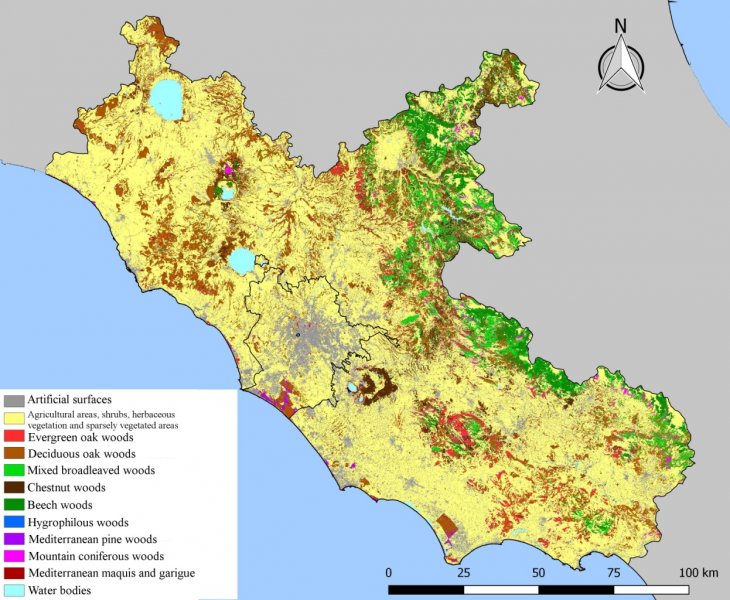 Figure 1: Land cover classification of the Latium region from a Sentinel-2 image – year 2016 (10 m2 spatial resolution). The classification yielded 11 different land cover classes, including 7 different physiognomic-structural categories of vegetation. The area inside the outline represents the municipality of Rome (from Fusaro et al., 2017)
Figure 1: Land cover classification of the Latium region from a Sentinel-2 image – year 2016 (10 m2 spatial resolution). The classification yielded 11 different land cover classes, including 7 different physiognomic-structural categories of vegetation. The area inside the outline represents the municipality of Rome (from Fusaro et al., 2017)
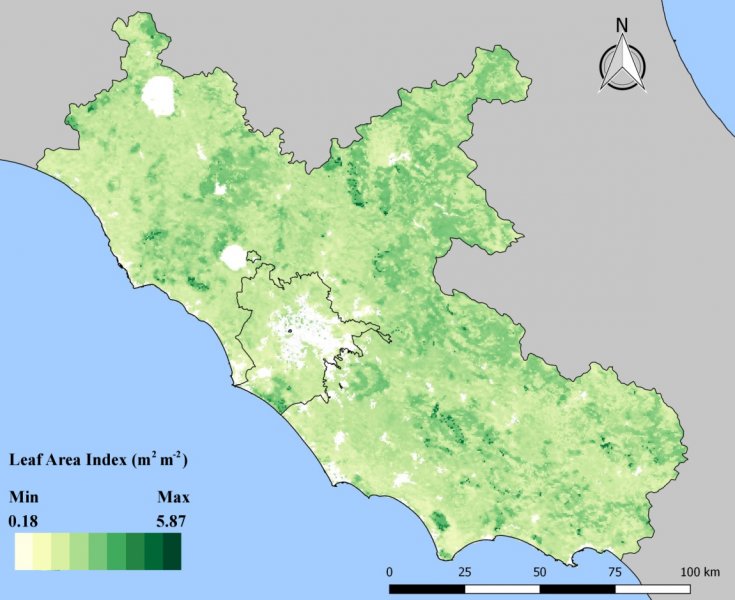
Figure 2: Yearly average Leaf Area Index (LAI, m2/m2) values (2016) retrieved from the MOD15A2H MODIS product for the Latium region. Higher LAI values can be found in correspondence of dense forest stands, in particular in peri-urban areas. The area inside the outline represents the municipality of Rome (from Fusaro et al., 2017)
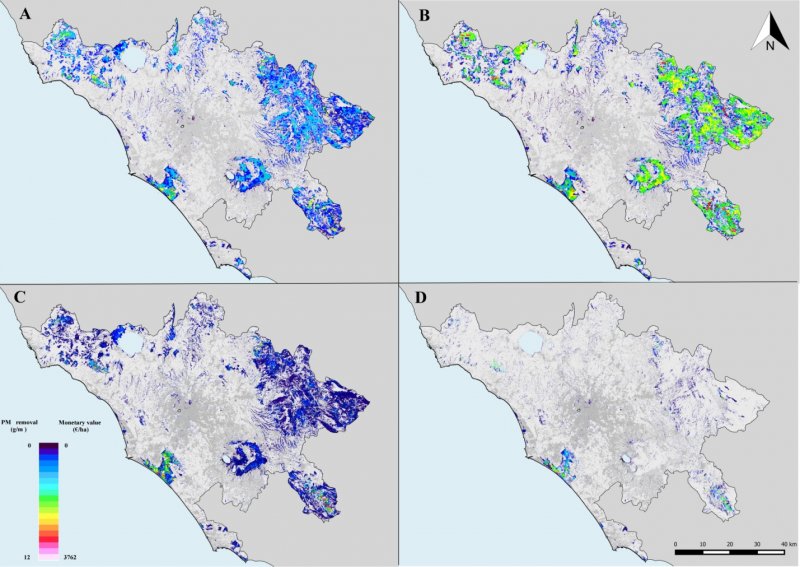
Figure 3: seasonal PM10 removal by the vegetation of the Metropolitan City of Rome (in g/m2), calculated following the methodology described in Marando et al. (2016) using monitoring stations data for PM10, and relative monetary value (in €/ha) calculated on the basis of externality values (EEA, 2014) – Modified from Marando et al. (2016)
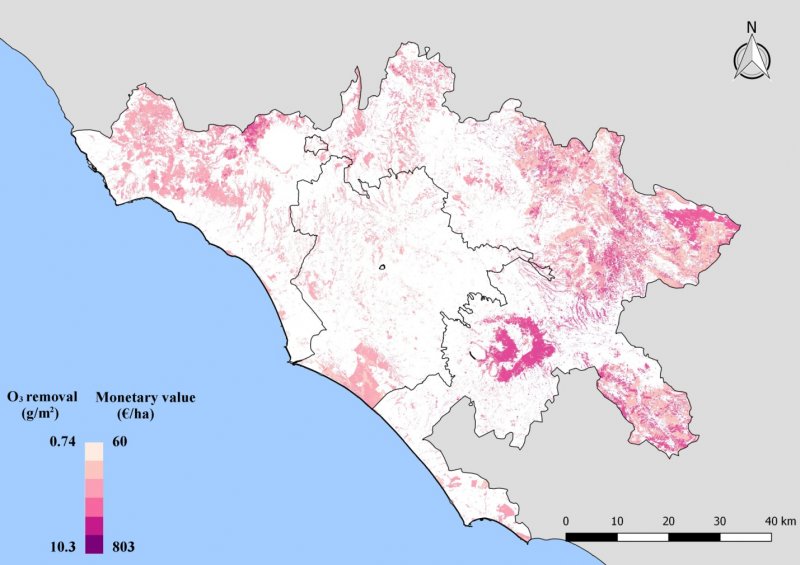
Figure 4: O3 absorption by the vegetation of the Metropolitan City of Rome (in g/m2), calculated following the methodology described in Fusaro et al. (2017) using an emission-based pollution model (AMS-MINNI, Mircea et al., 2014), and relative monetary value (in €/ha) calculated on the basis of externality values (EEA, 2014). Modified from Fusaro et al. (2017).
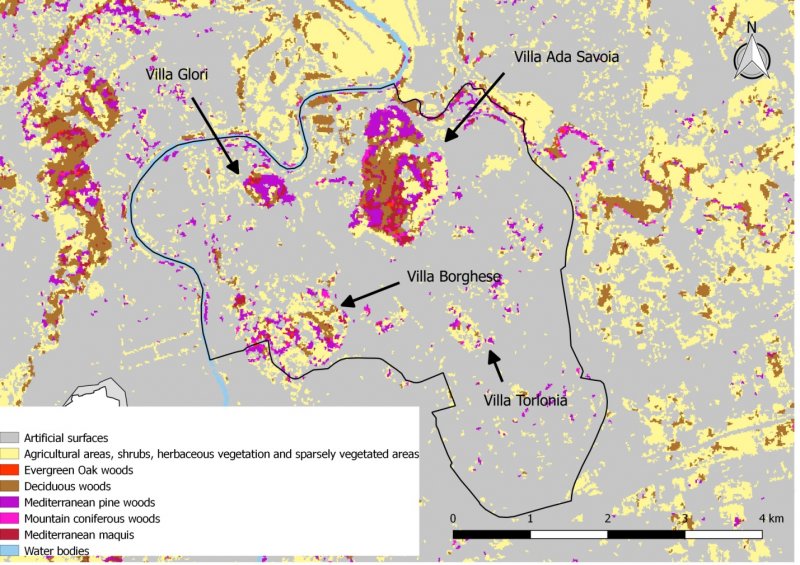 Figure 5: Classification of the land cover of the II district. Arrows indicate the location of the different historical villas present in the Municipio.
Figure 5: Classification of the land cover of the II district. Arrows indicate the location of the different historical villas present in the Municipio.
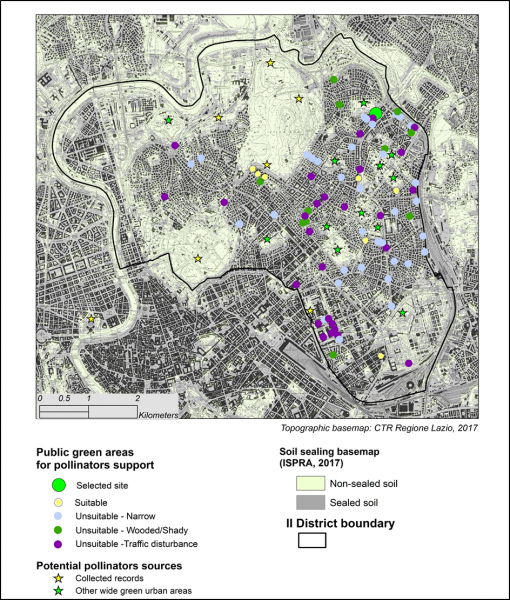
Figure 6. The map represents the spatial basic information for planning pilot projects for pollinators support in the II District of Rome.
Stars represent recorded/potential population sources for wild pollinators (from literature and land cover data, respectively). Circles represent green spaces directly managed by the II District that are classified according to their suitability/unsuitability for hosting pollinator support actions (extent of the site, present cover of trees, disturbance from vehicular traffic, distance from potential pollinator population sources). The green circle shows the selected site for the pilot project (600 sqm, maximum suitability and high provisioning potential for the expected cultural ecosystem service).
|
Family |
Species |
Indicative flowering period |
Life form |
Elevation range of natural distribution |
|||
|
Winter |
Spring |
Summer |
Fall |
||||
|
FABACEAE |
Cercis siliquastrum L. |
x |
P |
0-800 |
|||
|
ERICACEAE |
Arbutus unedo L. |
x |
x |
P |
0-900 |
||
|
MYRTACEAE |
Myrtus communis L. |
x |
P |
0-500 |
|||
|
CAPRIFOLIACEAE |
Lonicera implexa Aiton |
x |
x |
P |
0-800 |
||
|
ERICACEAE |
Erica multiflora L. |
x |
NP/P |
0-600 |
|||
|
LAMIACEAE |
Rosmarinus officinalis L. |
x |
x |
NP/P |
0-800 |
||
|
LAMIACEAE |
Lavandula angustifolia Mill. |
x |
x |
NP |
0-400 |
||
|
LAMIACEAE |
Lavandula stoechas L. |
x |
x |
NP |
0-400 |
||
|
LAMIACEAE |
Teucrium chamaedrys L. |
x |
x |
Ch |
0-1700 |
||
|
LAMIACEAE |
Thymus sp. pl. |
x |
x |
Ch |
0-1600 |
||
|
LAMIACEAE |
Satureja montana L. |
x |
x |
Ch |
100-1300 |
||
|
CISTACEAE |
Helianthemum nummularium (L.) Mill. subsp. obscurum (Čelak.) Holub |
x |
x |
Ch |
200-1400 |
||
|
CRASSULACEAE |
Sedum sexangulare L. |
x |
x |
Ch |
50-2000 |
||
|
BRASSICACEAE |
Lobularia maritima (L.) Desv. |
x |
H/Ch |
0-300 |
|||
|
LAMIACEAE |
Salvia verbenaca L. |
x |
x |
x |
x |
H |
0-1400 |
Figure 7. Preliminary list of species to be planted in the site for the pilot project on pollinators support in the II District of Rome. The list is compiled according to: high pollinator support capacity of the plant species and of respective genus and family; native status in the metropolitan area of Rome (autochthonous species of different ecoregions and natural habitats of the Metropolitan City); complete species biology; prevalent perennial life form (especially P/NP-Phanerophytes/Nanophanerophyte, Ch-Chamaephytes and few H-Hemicryptophytes); long-lasting individual or comprehensive flowering phenology (continuous nectar and pollen sources from winter to fall). Data sources: Anzalone et al., 2010; Capotorti et al., 2013; Celesti-Grapow et al., 2013; Pignatti, 2017; http://dryades.units.it/Roma/index.php.
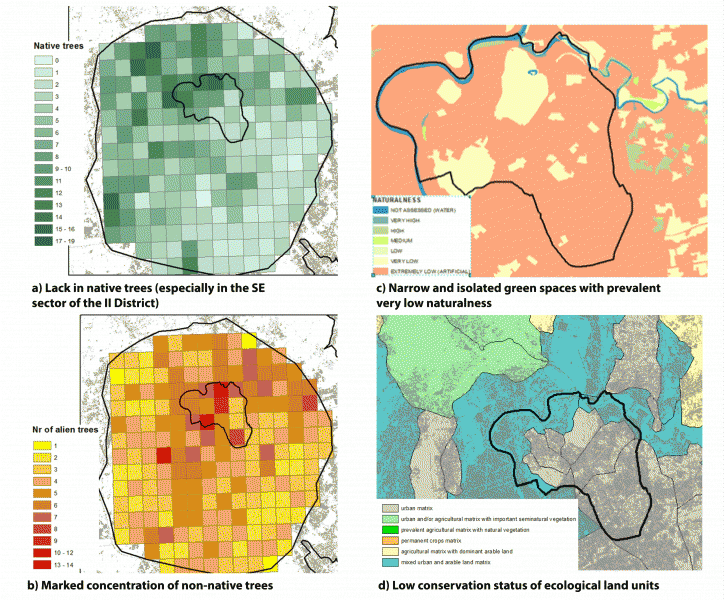
Figure 8: Critical conditions for species (a and b, on the left side) and ecosystems (c and d, on the right side) in the II District of the Municipality of Rome (black outline). Basic data are derived from: Celesti-Grapow 1995; Capotorti et al., 2013, 2015, 2017; CIRBFEP, 2013).
The information is useful to prioritise both sites and actions for the deployment of a GI at the local scale (e.g. where to first plant native trees and restore natural vegetation communities; where to foster progressive replacement of no-native plant species; where to especially enhance ecological connectivity between green spaces; where to recreate open spaces).
Even though it is known that vegetation plays an important role in the removal of pollutants, none of the criteria currently applied for managing green spaces in the city relate to effective air pollution and climate mitigation. Probably, the fragmentation of responsibilities among different departments within the administrative bodies hinders this connection, which is very important for environmental issues and health. Results from the current and from other studies demonstrated that these issues are no watertight and that they should be tackled by means of an integrated approach. For instance, benefits from proper selection of vegetation species in a city could be assessed in terms of load of pollutants removed from the atmosphere, and furthermore, these data can be translated into health benefits. In synthesis, the policy relevance of the City Lab consists of:
- Raised awareness of the public administration about the importance and effectiveness of NbS and regulating and cultural ES in the city
- Adaptation of green space planning and management to the principles of the National Strategy for Urban Green (MATTM, 2018)
- Active promotion of urban green spaces as multifunctional systems that are significant for sustainable development, providing substantial ES for human well-being
- Actual support for improving investments in deployment of urban GI
The key messages that are being effectively transferred to the local policymakers are:
- A deeper knowledge on the role of different vegetation types is crucial to ameliorate detrimental environmental conditions (e.g. poor air quality, heat island effect, scarce pollination support) and health-related quality of life
- Multiple motivations for conserving urban biodiversity include:
- To provide ES to improve human health and well-being in a global change context;
- To preserve important local biodiversity and ecological corridors and deploy sustainable GI
- To promote NbS and urban ecosystem resilience for addressing global changes
- To provide cultural ecosystem services
- There is the need for restoring abandoned urban sites, both built and not-built, aimed at increasing urban and peri-urban forest and maintaining local biodiversity structure and function
- There is the need to coordinate the activities among the environment, health and mobility decision-makers to better transfer the scientific knowledge obtained by the multidisciplinary studies of GI in metropolitan areas and in elaborating plans for improving the quality of citizens lives
The City Lab of Rome provides empirical evidence on the importance of enhancing ecosystem condition and preserving ecosystem functions for sustaining the provision of multiple ES.
It demonstrates that structural characteristics (e.g. LAI, species diversity) and functional diversity (e.g. stomatal conductance) of urban and periurban forests are key morpho-functional parameters for regulating ES estimation.
The challenges are i) to plan a GI that is able to jointly support biodiversity (benefits for the environment) and ES (benefits for citizens) and ii) to apply a multi-scale approach for addressing the different GI targets.
The opportunities are i) to integrate multiple disciplinary approaches for the implementation of Nature-Based solutions that can improve human health and well-being in urban and peri-urban areas and ii) to interface with policy makers that have concrete local responsibilities
These findings suggest the need to transfer this knowledge to society, also for a cultural growth and in accordance to SDGs UN agenda to 2030 and in particular with 3, 11, 13, and 15 objectives.
To date, in the methodological approach adopted by the City Lab of Rome, a number of limitations were present. In particular, the spatialization of air pollution data was not feasible regarding O3 because too few monitoring stations on the territory are present. Therefore an emission-based modelling system (AMS-MINNI) was adopted for O3. Another limitation is the lack of methodologies/instruments to validate properly the regulating ES and to test for effectiveness of the adopted measures. Furthermore, our estimates of PM10 and O3 removal by vegetation are based on approximations of two key input parameters described in the models, in particular PM10 deposition velocity to plant canopy (Vd) and plant stomatal conductance (gs). Vd in fact depends not only on the LAI, as assumed in our methodology, but also on atmospheric conditions such as air temperature, wind speed, and relative humidity (Mohan, 2016), and is thus affected by dynamics dependent by site characteristics and time, that were not addressed in our work. Furthermore, the use of an annual average gs value for each vegetation group does not allow the estimation of site-specific time dependent trends in O3 fluxes. Therefore, the amount of O3 removed by vegetation could have been overestimated, particularly under Mediterranean conditions (Fusaro et al., 2015a, 2015b; Manes et al., 2007, 2012, 2016).
As regards pollinators support, important limitations are posed by the lack of updated and locally sampled data on occurrence and distribution of wild bees in the selected green spaces. The lack of data is expected to be overcome in the near future by expanding the early result of the Enroute City Lab. In this regard, an interdisciplinary research has been designed for applying the ESTIMAP modelling to the wider metropolitan area of Rome in keeping with the prescriptive rules of the Land Ecological Network (Blasi et al., 2008).
As regards the promotion of native species and natural ecosystems in the framework of GI planning, main limitations are posed by: poor investments on basic knowledge (faunistic, floristic and vegetation sampling); lack of fine assessments of ecosystem conditions in terms of structure and composition; lack of local scale evidences on the relationships between ecosystem conditions and ES capacity; weak expertise on potential disservices within the interdisciplinary team.









